This article was established by students of the Master in European Contemporary History at the University of Luxembourg in the context of the course Digital Humanities and has the objective to present a wide range of Digital Humanities projects. By presenting these projects the article will furthermore help to explain what Digital Humanities are.
Contents
1. Introduction
Finally an easy definition of Digital Humanities
Since this article tries to reach every interested reader, from digital humanists to those who are completely new to this emerging discipline, we want to start with a basic definition:
“The Digital Humanities are an area of research, teaching, and creation concerned with the intersection of computing and the disciplines of the humanities. […] Digital humanities (often abbreviated DH) currently incorporate both digitized and born-digital materials and combine the methodologies from traditional humanities disciplines (such as history, philosophy, linguistics, literature, art, archaeology, music, and cultural studies) and social sciences with tools provided by computing (such as data visualisation, information retrieval, data mining, statistics, text mining) and digital publishing.”
This definition provided by wikipedia explains in a clear way what Digital Humanities are. If this definition doesn’t seem clear to everybody, we are sure that the examples in this article will give the reader a clear idea of the discipline. Since we have started with a basic definition, we now take a brief look back, yes we are historians, how humanities and computer technology came together.
The love story of humanities and digital technology
Frédéric Clavert and Serge Noiret, both historians and experts in Digital Humanities and Digital History, insist that there have been two main stages in the history of computer technology which “have changed the ways they are used in humanities”. ((Cf. Frédéric CLAVERT / Serge NOIRET: Introduction. Digital Humanities and History. A New Field for Historians in the Digital Age. [in:] Frédéric CLAVERT / Serge NOIRET (eds.): L’histoire contemporaine à l’ère numérique. Contemporary History in the Digital Age. Brussels 2013, p. 15-29, esp. p. 18. Hereafter referred to as CLAVERT / NOIRET: Digital Humanities and History.))
The first main stage was the spread of the Personal Computer at the end of the 1970s. Clavert and Noiret say that especially with the development of graphic interfaces like the commonly known Apple Macintosh and Microsoft Windows and associated softwares like spreadsheets and databases the computer usage became easier and thereby was more and more used in humanities. ((Ibid., esp. p. 18f.)) Peter Haber, historian and expert in Digital Humanities and Digital History, gives the development of the first Personal Computer’s a similar importance. He adds that computer technology thereby slowly established itself and overtook the good old typewriter and that it became a more common “tool” for historians. ((Cf. Peter HABER: Digital Past. Geschichtswissenschaft im digitalen Zeitalter. Munich 2011, p. 25.))
The second stage goes back to the end of the 1980s, with the development of the Internet and in the mid- 1990s with the development of the World Wide Web (WWW). Clavert and Noiret insist that the usage of computer technology in humanities really started to emerge around the 2000s with “the expansion of the possibilities of the web”. ((Cf. CLAVERT / NOIRET: Digital Humanities and History, esp. p. 19.))
What to find in this article?
In the major part of our article we will present some of the projects which have been done in recent years in the context of Digital Humanities. We have chosen 8 projects which we think are interesting: European History Online, Serendip-o-matic, Mapping Luxembourg, Corpus Corporum, Our Marathon, Voyant Tools, the Centre Virtuel de la Connaissance sur l’Europe and Orbis. We have analyzed a wide range of projects, not only scientific one’s but also fun projects, in order to make our article interesting and not to repeat ourselves. Lastly, we have decided not to go into too much detail since this article shall only be a basic introduction into specific projects. Nevertheless, we think that with the basic information we give, the reader will be able to understand the general concepts and functions of the respective project and will in a next step be able to discover it himself.
2. Projects
European History Online
European History Online (EHO) bases on a cooperation between the Institute of European History in Mainz, the Center for Digital Humanities in Trier and the Bavarian State Library in the year 2010. The project itself is an open-access Web page and has the objective to present the modern History of Europe in a transnational or global perspective, while connecting an interdisciplinary approach (using e.g. Geography, Law studies) with different historical methods (e.g. comparative history, transnational history). ((European History Online Wikipedia « http://en.wikipedia.org/wiki/European_History_Online » (accessed on 21 April 2014)) The chosen time-period of this project reinforces this idea, because European History Online starts in the mid 15th century and ends in 1950. European History Online surpasses thereby the classique narrative of Europe’s History, which often is presented as a History of the European integration. The webpage is bilingual (English, German) and features digitized (e.g. Documents, maps) as well as born-digital (e.g. Texts, documents) sources. Regarding this, the installation of a “language choice” button allows the reader to either read the specific articles in German or in English.

Since its creation, European History Online has until now published about 200 born-digital articles, which focus on several topics concerning European History. To the articles are added footnotes which contain among others primary sources such as maps, pictures, statistics and audio as well as video links. In some cases European History Online offers a description of these sources. This type of footnote information is an interesting addition to digital-born articles which isn’t possible in books. For example, in the article “Censorship and Freedom of the Press” by Jürgen Wilke we clicked on the footnote “the Congress Vienna of 1815” and received the following map with a brief description of the Congress of Vienna.
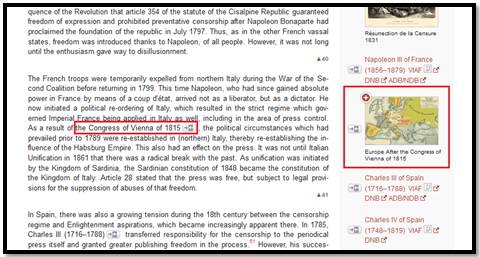
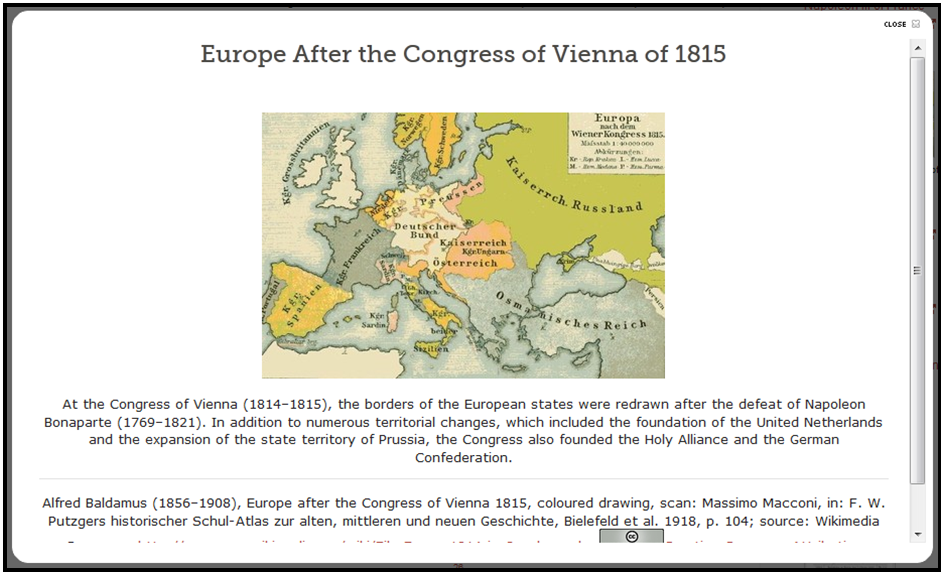
Furthermore, European History Online uses a Twitter account @ieg_ego, in order to inform readers about new article publications. In conlusion, European History Online is an interesting example because the project shows how Digital Humanities can create new history writing as well as possibilites for publication and can add new aspects to research such as the footnote information.
Serendip-o-matic
Serendip-o-matic is the outcome of the One Week | One Tool project which was held at the University of George Mason in 2013. For one week several digital humanists from different disciplines came together in order to work on one project. In general, Serendip-o-matic is a research engine which combines several online archives in one. The user can copy paste single words or a full text in the research box and Serendip-o-matic identifies the keywords and looks where it can find digitized material in online libraries or archives such as Europeana, the Digital Public Library of America and Flickr Commons. This can allow users to find documents, maps and other digitized sources which stand in the context of his text. The autonomous function can give the research a new look by presenting sources which the user in the first case might not have considered. As an example, we used the wikipedia entry on “World War I”.
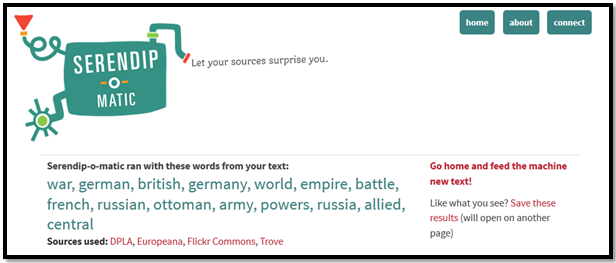
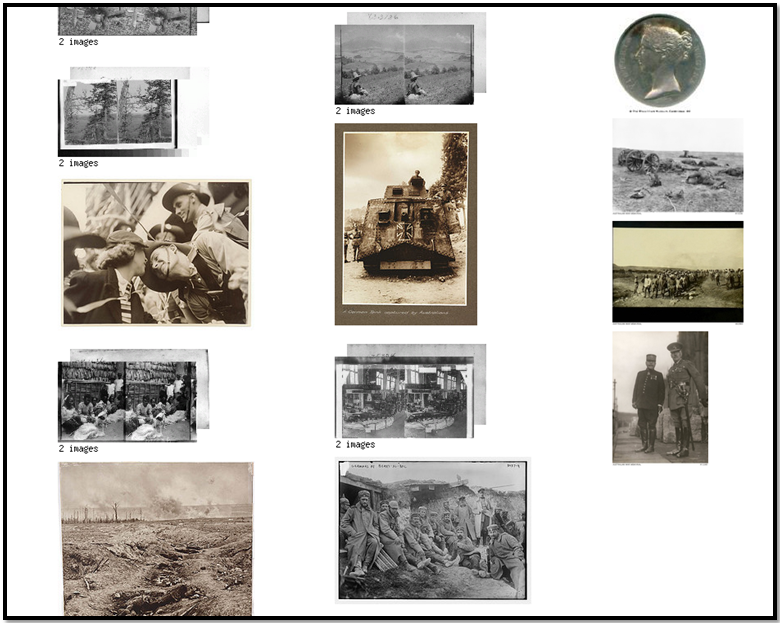
After the research the user can collect the exact link adresses of the found documents in order to save them. ((Franziska Heimburger: Vos sources vous surpennent avec le Serendip-o-matic. Boîte à outils (published on 2 August 2013) « http://www.boiteaoutils.info/2013/08/vos-sources-vous-surprennent-avec-le.html » (accessed on 18 April 2014)) Furthermore, since Serendip-o-matic is linked to Zotero the user can establish a research, which browses his zotero bibliography. However the uselfulness of Serendip-o-matic is restricted, because only a few online libraries or archives are part of the project. Nevertheless the idea of the tool is interesting because it gives the researcher a different look at the research field which he probably hadn’t envisionned and thereby can lead to new source material.
.
Mapping-Luxembourg
“Mapping–Luxembourg” is a cooperation between the National Archives of Luxembourg and the Musée d’histoire de la ville de Luxembourg and has been online since the beginning of March 2014. The project itself allows the user to see a variety of historical maps of the city of Luxembourg. The time span of these maps extends from the 17th to the 21th century. In this sense, the user is able to browse between fifty historical buildings and thirteen regions of the city. In order to access information about a certain building or region, you only need to click on one of the tags you are interested in. By doing so, a brief text about the historical background and the development of the designated building pops up. In addition to this text, depending on the resources, historical maps and pictures over the course of a few centuries appear. Furthermore, it is important to add that this tool is using Google Maps as a basic operator for the project.
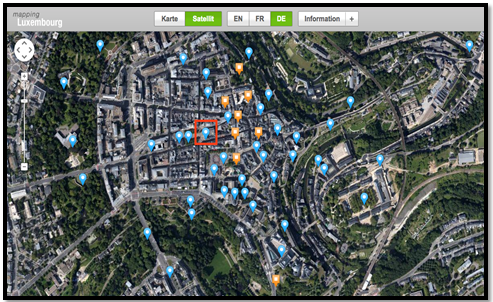
In total three Luxembourgish institutions helped to gather the document material “Mapping-Luxembourg”: The National Archives, the Musée d’histoire de la ville de Luxembourg and the Photothèque. ((Musée d’histoire de la ville de Luxembourg / Archives nationales de Luxembourg: “Mapping Luxembourg” Historische Karten und Ansichten der Stadt Luxemburg online. « http://www.gouvernement.lu/3578168/Mapping-2014-Communique-D.PDF » (accessed 25 March 2014))) Users can chose between three languages: English/ German/ French, and two viewing formats: Satellite and a Map. ((Cf. Stadtgeschichte aus der Vogelperspektive. Wort.lu (published 19 March 2014) « http://www.wort.lu/de/view/stadtgeschichte-aus-der-vogelperspektive-53296150e4b0b484f80871b8 » (accessed 17 April 2014)))
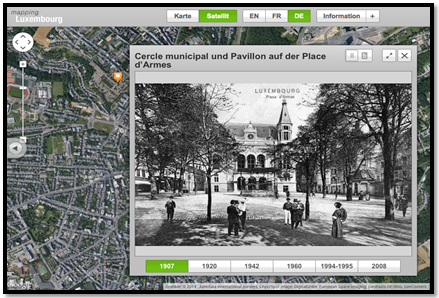
To conclude it can be said that this tool is first of all useful for tourists who would like to get some information about the history of the city of Luxembourg. Secondly, residents of Luxembourg and people of Luxembourgish origins might also be interested in having a look at the historical backgrounds of the capital.
Corpus Corporum: Repositorium operum Latinorum apud universitatem Turicensem
Corpus Corporum is a project which was developed at the University of Zürich. In general, Corpus Corporum is a Latin text repository. At the moment users can find 5,785 works in Latin from 2,013 different authors. The corpora covers a huge time span, which includes for example the Old and New Testament of the Bible, Latin texts from antiquity and medieval times (e.g. Aristotle’s Physica, digitalisation of the Patrologia Latina, works of scientific authors, etc…), works from renaissance authors as well as Neo-Latin texts. The Corpus Corporum is a digital text archive which works together with other text repository projects but is also open to private text entries.
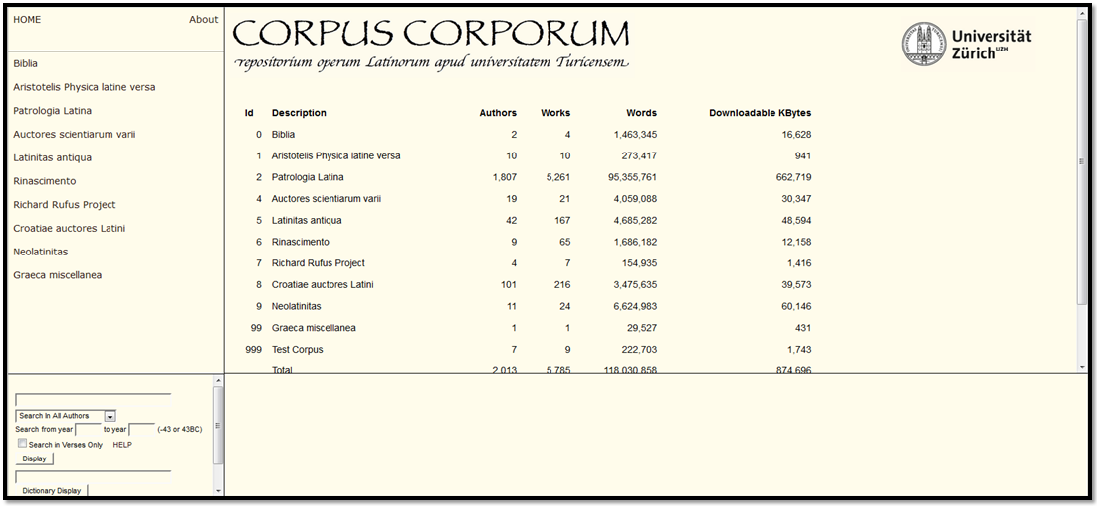
While the user goes through a text, he can click on a word and thereby receives information on the word form and a translation into English and German. However at this point we insist, that this function isn’t working for every word yet.


Furthermore the Corporus Corporum features a search engine which allows the user to browse through the uploaded texts and search for specific words, persons or events…

In conclusion, we think that Corpus Corporum is an interesting tool for students and researchers who work with Latin texts. The platform allows to use a wide range of Latin texts without having to browse the whole web or look up books. We think that especially with the word form and translation function the Corpus Corporum can be helpful in order to make research easier and thereby quicker. If the project manages to overcome function problems and steadily adds new text corpora it could become an important part of scientific research.
Our Marathon: The Boston Bombing Digital Archives and Wbur Oral History Project
“Our Marathon” is a project which has been established by the Northeastern University of Boston. Our Marathon is an online platform that collects videos, pictures and stories in relation to the Boston Marathon bombings on April 15th 2013. It is a crowd-sourced archive, which means that anyone who has relevant material is able to share it in this online archive. In this sense the user of Our Marathon can browse through the different visual and oral experiences of people that endured the bombings.
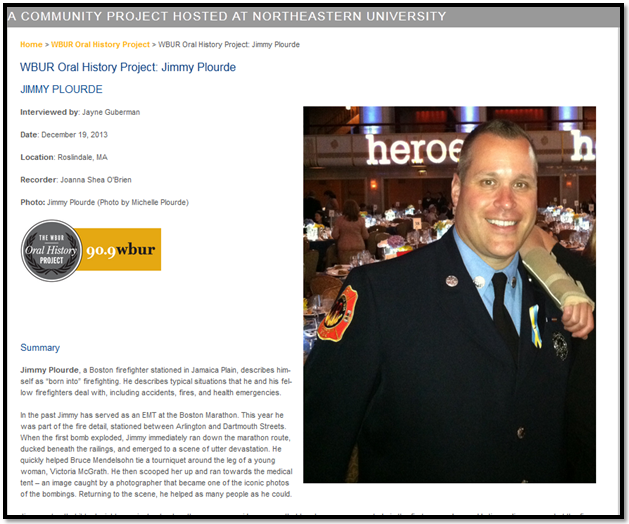
It is important for the creators of the project to underline that it´s not merely about what happened during the bombings. Instead, it is much more an attempt to compile a public record of how this tragic incident has affected the lifes of the witnesses. The main goal of this tool is to serve as a long-term memorial of the events that shocked the United States on April 15th 2013. ((Cf. About the Our Marathon Archive. Our Marathon « http://marathon.neu.edu/about » (accessed 26 March 2014)))

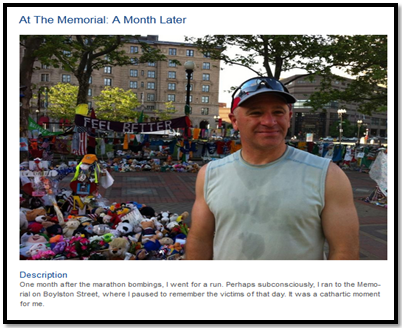
From a methodological standpoint Our Marathon a typical Digital Humanities project. This is mainly due to the fact that the creators of this tool combined methods that are used in scientific research, such as “oral history”, with a digital approach.
Voyant Tools
Voyant Tools is a project which is led by Stéfan Sinclair, Associate Professor of Digital Humanities at the Mc Gill University and Geoffrey Rockwell, Professor of Philosophy and Humanities Computing at the University of Alberta. In general, Voyant Tools is a text analysis tool which allows to receive information on the word count and word frequency. The user has the possibility to click on the most frequent words which allows him to directly search for interesting passages. In order to start, the user can copy-paste a text or he can simply upload a document in the tool. As an example, we used the Wikipedia entry on “Digital Humanities”.

In order to see which words appear most in the text the user can click on the “words in the corpus box” function. Furthermore the researcher has the possibility to exclude common language words to make the word frequency analysis more effective.
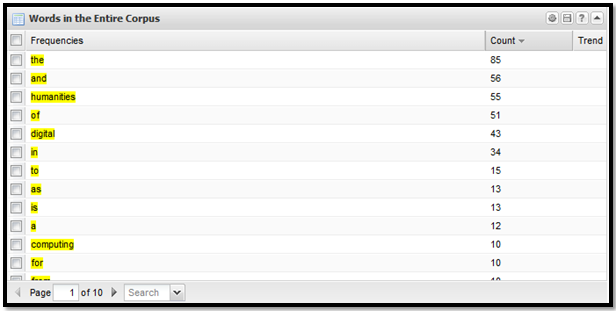
Moreover, the user has the ability to see in which parts in the text a word was used most with the “word trend” feature by simply clicking on a word in the “cirrus” field or in the “corpus reader”. In addition to this the user can use the function “keywords in context” in order to receive a quick overview in which context the word is used.
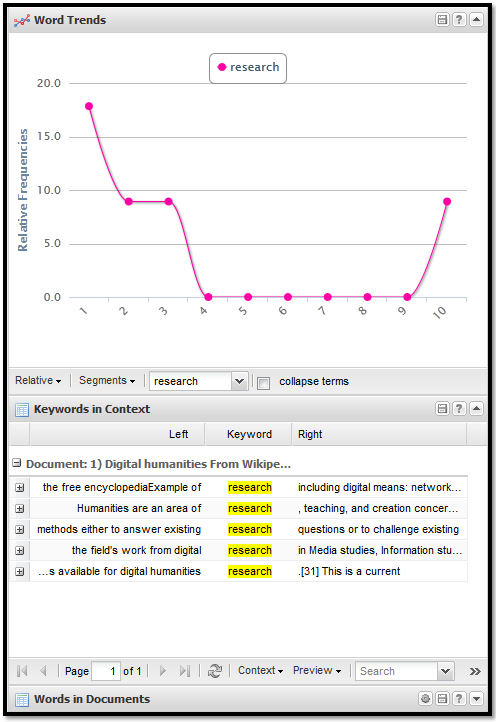
Voyant Tools is an interesting project example because it shows that Digital Humanities go further than creating archives and born-digital material. Digital Humanities also create new tools which add to scientific working, in this case in critical text analysis. In this sense, the word count of Voyant Tools can be helpful in order to analyse a writer’s narrative. For example, if a historian publishes an article on the history of the world and Voyant Tools displays that the word “Europe” appears much more in his narrative than other continents, then it is probable that the historian writes in a eurocentric way.
Centre Virtuel de la Connaissance sur l’Europe
The Centre Virtuel de la Connaissance sur l’Europe (CVCE) is a research and documentation center, situated in Sanem (Luxembourg), which treates the European integration process. Hence, the CVCE treats the time-period from 1945 until the present time. The CVCE Team regroups scientists from different disciplines such as economics, contemporary history, european law and political science. Furthermore the CVCE has set up a Digital Humanities Lab (DH Lab) in order to develop new tools which can facilate research as well as the teaching of European Integration studies. Through the medium of Digital Humanities, digitized (e.g. Texts, documents) and born-digital (e.g. Oral history) sources, are being used to create a historial narrative. The website can be read in English as well as in French. In principe, it is divided into three parts: Publications, Oral history, Research and Education. ((Cf. Jeff Koehler: Homepage Review CVCE. h-europe (uploaded 2 July 2012) « http://h-europe.uni.lu/?p=635 » (accessed 16 April 2014)))

Until now the CVCE has published 28 born-digital articles and projects online. In order to fulfill their slogan: “Knowing the past to build the future”, historical processes, such as the “Origins of the Rome treaties (1955-1958)”, are thematized. Furthermore, the CVCE has published several born-digital interactive maps on the topics: “Europe divisée (1945-1990)”, “Crises et conflits”, “Colonisations et décolonisations”, which have the objective to “create the geopolitical context of the european integration process”. ((CVCE: Interactive maps. The geopolitical context of European integration. « http://www.cvce.eu/content/publication/2013/7/15/667b05cc-0f90-4796-bafd-1f9849cb83a7/publishable_en.pdf » (accessed 19 April 2014))) In the context of “E-Learning”, these interactive maps can be especially helpful for educational purposes, because they allow teachers to demonstrate the development of a crisis or a war much more easily.
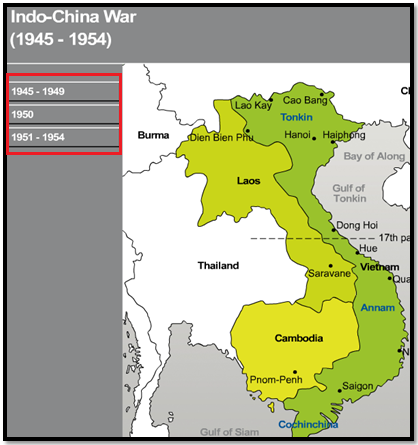
In the Oral History category the user can find several audio and videos interviews with 71 “key-players” and “eyewitnesses” in the european integration process as well as their biographies. The interviews can sometimes be watched in full length.

In the last category the user receives information on old and current research and educations projects of the CVCE. Furthermore the CVCE uses a Twitter account @CVCE in order to inform readers about news, calls and publications.
We used the CVCE project first and foremost because it is related to our university but nevertheless we think it is a good example in order to show how Digital Humanities projects create new archives, new publication possibilities as well as teaching material.
Orbis
Orbis is a project which was developped at the University of Stanford through the collaboration of historians and information technology specialists. Mainly, Orbis is a interactive map project which allows the user to calculate how much time and financial cost a transport of people and goods in the Roman Empire around 200 AD took. ((Cf. Curt Hopkins: Travel across the Roman Empire in real time with ORBIS. Google maps for the ancient world. Ars technica (published 18 May 2014) « http://arstechnica.com/business/2012/05/how-across-the-roman-empire-in-real-time-with-orbis/ » (accessed 14 April 2014))) The historian Walter Scheidel, who is directing the project, has collected several historical sources in order to establish the route calculations. In total 751 sites, which includes urban settlements, promontorys and mountain passes, can be selected. Orbis presents a realistic view because it takes into account month changes, wind changes and sea conditions which effect sea travel. The user can select a point of departure, a destination and several options (network mode, aquatic options, road options, price options). Furthermore, the user has the possibility to calculate the fastest, cheapest or shortest route.
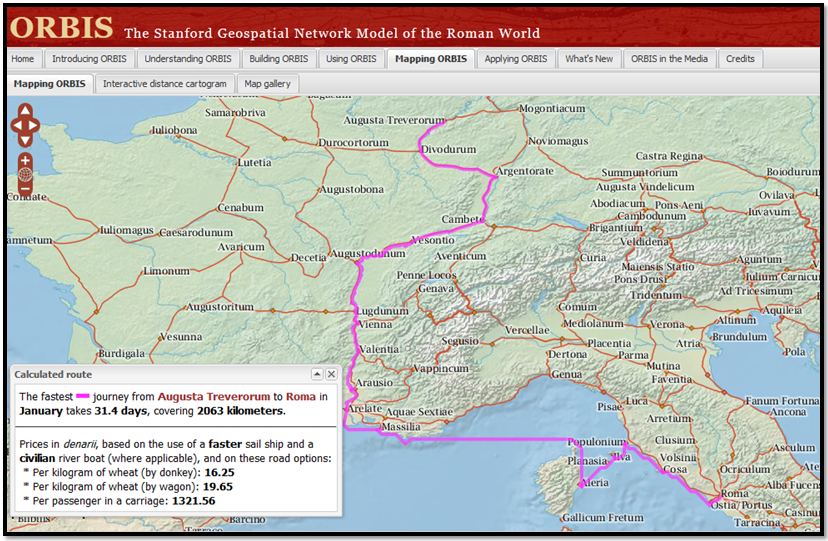
Afterwards the user can compare different travel routes in the “results grid”. We compared the fastest travel routes for a foot traveler from Rome (Roma) to Rouen (Rotomagus) in January and July. In our case the user sees that for ancient people the route in winter took longer (in this case 26 days in July and 35 days in January) and was much more expensive (higher costs for donkey, wagon as well as passenger transport) than in summer because the travellers were obliged to take the road over land and couldn’t take the quicker road over sea along the coasts of modern-day France because of different wind patterns and sea conditions. ((Cf. Elijah Meeks: ORBIS Demo: Calculating Routes. Youtube (uploaded 1 Mai 2012) https://www.youtube.com/watch?v=KwoshD3esdc (accessed 14 April 2014)))
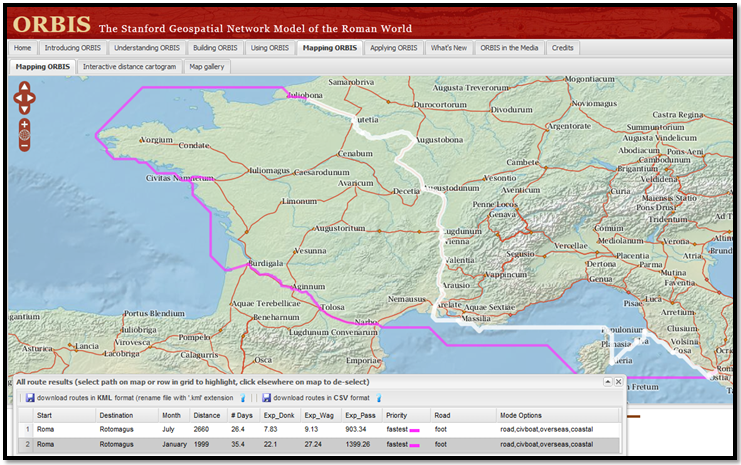
The objective of Orbis is helping to understand how the Roman Empire was connected and how the empire was able to control its inhabitants although the different settlements where separated by large distances over land and sea. ((Cf. Understanding Orbis. Orbis « http://orbis.stanford.edu/#understanding » (accessed 14 April 2014))) Furthermore, we think that this project, although it can be criticized for being anachronistic, is useful in order to explain travel in ancient society especially for education purposes by visualising ideas.
3. Conclusion
What do we learn from the analyzed projects? The main characteristics of the analyzed Digital Humanities projects are that they allow to “archive”, “visualize” and “publish”.
By “archiving” we mean establishing new archives or regrouping sources (e.g. Documents, interviews), like in the projects European History Online, Corpus Corporum, Our Marathon and CVCE. Furthermore one major addition, in our opinion, which Digital Humanities projects add to research is “crowd-sourcing”, which means that people from everywhere can add material to the respective archives by submitting sources out of their private archives like in the projects Our Marathon and Corpus Corporum. Although this source method isn’t present in history projects such as European History Online and CVCE, it could enlarge the source field by “giving” researchers access to private collections. However as Frédéric Clavert insists, researchers still have to be sceptical regarding crowd-sourcing material and question its credibility. ((Cf. Frédéric CLAVERT: Conclusion. [in:] Frédéric CLAVERT / Serge NOIRET (eds.): L’histoire contemporaine à l’ère numérique. Contemporary History in the Digital Age. Brussels 2013, p. 347-355, esp. 353.))
By “visualizing” we mean displaying primary sources, such as pictures and videos, and demonstrating events or developments. European History Online, Mapping-Luxembourg, CVCE and Our Marathon all allow the user to discover primary sources without having to hold them in hand. This element brings a new dimension to research and makes it much quicker. Furthermore European History Online, CVCE and Orbis allow to demonstrate for example by using interactive maps. This possibility can be useful in order to explain for example political changes and war developments to students by visualizing otherwise theoretical stuff.
By “publishing” we mean establishing born-digital material and creating new publication possibilites other than in book format, like in the projects European History Online and CVCE. In the context of “publishing on the web” we want to point out that Digital Humanities however still face several challenges which need to be resolved (i.a. authorship rights, retracing sources back to their origins, text stability, financial compensation of authors). ((Cf. Frédéric CLAVERT: Conclusion. [in:] Frédéric CLAVERT / Serge NOIRET (eds.): L’histoire contemporaine à l’ère numérique. Contemporary History in the Digital Age. Brussels 2013, p. 347-355, esp. 353.))
Next to these major characteristics, Digital Humanities projects such as the text analysis tool Voyant Tools create new features which can help to develop scientific work. However, the user has to keep in mind that these tools are often limited and can lead to misinterpretation. Lastly, we find it quite interesting that even fun projects such as Serendip-o-matic can be useful for research since it changes the researcher’s selection of sources.
Looking back at this conclusion, we think there is no doubt that Digital Humanities will be an important part of scientific research and teaching in the future. What do you think? Finally, we hope that this article has helped the reader to receive a clear idea of the notion “Digital Humanities”.
If you are interested in having further information on projects in Digital Humanities we recommand you to visit DHCommons, CUNY Academic Commons, Digital Humanities Now and Digital Humanities Awards.
4. Bibliography
CLAVERT, Frédéric / NOIRET, Serge (eds.): L’histoire contemporaine à l’ère numérique. Contemporary History in the Digital Age. Brussels 2013.
HABER, Peter: Digital Past. Geschichtswissenschaft im digitalen Zeitalter. Munich 2011.
_________________
Article by Frédéric JUNCK & Jean KETTER of the Master in European Contemporary History, 1st year, summer term 2013/2014, University of Luxembourg

“Exploring recent Digital Humanities projects | h-europe” http://t.co/jqlCZXLMhP